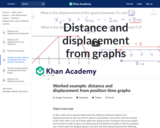
How cameras capture images using an aperture.
- Subject:
- Applied Science
- Arts and Humanities
- Computer Science
- Graphic Arts
- Material Type:
- Lesson
- Provider:
- Khan Academy
- Provider Set:
- Pixar
- Author:
- Disney Pixar
- Khan Academy
- Date Added:
- 07/14/2021


How cameras capture images using an aperture.

What is the limit of computer memory? Created by Brit Cruise.

What is Cryptography? A story which takes us from Caesar to Claude Shannon. Created by Brit Cruise.

A broad introduction to this field of study. Created by Brit Cruise.

Want to keep learning? Keep going with our course on Khan Academy!

What is the internet? Short answer: a distributed packet-switched network. This is the introduction video to the series, "How the Internet Works". Vint Cerf, one of the "fathers of the internet" explains the history of the net and how no one person or organization is really in charge of it.

Inventor and designer May-Li Khoe and virtual reality designer Nat Brown introduce the four features that all computers share.

Help decide what's next! What do you want to learn? Created by Brit Cruise.

In this video we show you how to create Bit-zee's fenders out of hair dryer motor mounts and we also take you through how to mount the hair dryer motors in Bit-zee's frame. Created by Karl Wendt.

White and Black Dwarfs. Created by Sal Khan.

Why S-Waves Only Travel in Solids. Created by Sal Khan.

Why Cepheids Pulsate. Created by Sal Khan.

Understanding why distance is area under velocity-time line. Created by Sal Khan.

Why Gravity Gets So Strong Near Dense Objects. Created by Sal Khan.

Software engineer Tess Winlock introduces how the physical infrastructure of the Internet moves information.

Wiring SPDT switches. Created by Karl Wendt.

David explains the link between work and kinetic energy. Created by David SantoPietro.

David shows how the area under a force vs. position graph equals the work done by the force and solves some sample problems. Created by David SantoPietro.

Learn how to use Punnett squares to calculate probabilities of different phenotypes. Includes worked examples of dihybrid crosses. independent assortment, incomplete dominance, codominance, and multiple alleles.

Worked examples finding displacement and distance from position-time graphs.